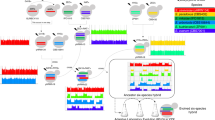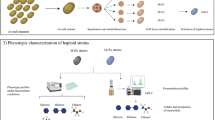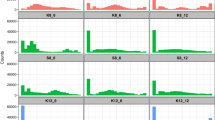Abstract
HAPLOPHASE yeasts capable of fermenting galactose ordinarily produce gas in from sixteen to thirty-six hours at 30° C. after inoculation into nutrient medium containing galactose. Winge and Roberts1 studied clones which fermented the sugar in from three to fourteen days after they were seeded in galactose yeastants to the time required by the cells in the haploid popu extract medium. Following the adaptation period, however, the rate of fermentation was identical with that of ordinary galactose-fermenting yeasts. In their analyses, they found that two haploid segregants from asci heterozygous for galactose fermentation were the ordinary fast fermenters and the other two were ‘long-term’ adapting clones. They attributed the delay in fermentation of the ‘long-term’ adapting segreglation to build up galactozymase to a concentration sufficient for the detection of its presence. The regular segregations of fast/'long-term’ adapting phenotypes among the haploid progeny were offered as proof that delayed fermentation of galactose is controlled by a specific allele. Such originally 2: 2 fast/'long-term’ tetrads were transformed into 4: 0 fast/'long-term’ ratios by extended cultivation in galactose yeast extract medium. Winge and Roberts considered that under these conditions there was no change in the population but merely a ‘long-term’ adaptation of the entire population. In proposing this view, they denied the occurrence of mutations as a factor operative in the ‘long-term’ adaptation, and held that de-adaptation of an adapted clone, as well as its subsequent re-adaptation to galactose, were effected through a modification.
This is a preview of subscription content, access via your institution
Access options
Subscribe to this journal
Receive 51 print issues and online access
$199.00 per year
only $3.90 per issue
Buy this article
- Purchase on Springer Link
- Instant access to full article PDF
Prices may be subject to local taxes which are calculated during checkout
Similar content being viewed by others
References
Winge, O., and Roberts, C., C.R. Lab. Carlsberg (Physiol.), 24, 263 (1948).
Lindegren, C. C., and Lindegren, G., Cold Spring Harbor Symp. Quant. Biol., 11, 115 (1947).
Mundkur, B. D., and Lindegren, C. C., Amer. J. Bot. (in the press).
Lindegren, C. C., “The Yeast Cell’ (Educational Publishers, St. Louis, 1949).
Mundkur, B. D., Ann. Missouri Bot. Gard., 36, 259 (1949).
Author information
Authors and Affiliations
Rights and permissions
About this article
Cite this article
MUNDKUR, B. 'Long-Term’ Adaptation and Non-Mendelian Inheritance in Yeast. Nature 164, 614–615 (1949). https://doi.org/10.1038/164614a0
Issue Date:
DOI: https://doi.org/10.1038/164614a0
This article is cited by
-
The genetic situation concerning fermentation in yeasts
Heredity (1952)
Comments
By submitting a comment you agree to abide by our Terms and Community Guidelines. If you find something abusive or that does not comply with our terms or guidelines please flag it as inappropriate.



